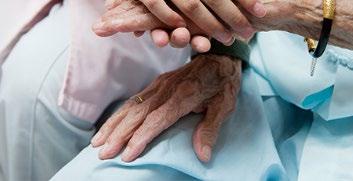
6 minute read
Turning Anger into Action: Minority Students Analyze COVID Data
TURNING ANGER INTO ACTION: Minority Students Analyze COVID Data on Racial Disparities
By Esther Landhuis As the coronavirus swept into Detroit this spring, Wayne tive developed by San Francisco researchers and funded by the National Institutes of Health, State University junior Skye Taylor will look at that question Taylor noticed something strik- and other effects of the pandemic. ing. On social media, many of She’s one of 70 participants from her fellow Black classmates who backgrounds underrepresented in live or grew up in the city were science who are learning basic “posting about death, like, ‘Oh, coding and data analysis methI lost this family member to ods to explore disparity issues. COVID-19,’” said Taylor. Data to address racial discrep-
The picture was different in ancies in care and outcomes has Beverly Hills, a mostly white been spotty during the pandemic, suburb 20 miles away. “People and it isn’t available for most I went to high school with aren’t of these students’ communities, posting anything like that,” which disproportionately bear Taylor said. “They’re doing the brunt of the virus. The particwell, their family is doing OK. ipants are “asking questions from And even the ones whose family a perspective that we desperately members have caught it, they’re (Ada Yokota/Getty Images) need, because their voices aren’t still alive.” really there in the scientific community,” said Alison Gammie, who
How do COVID-19 infection rates and outcomes differ between these directs the division of training, workforce development and diversity at ZIP codes? she wondered. How do their hospitals and other resources the National Institute of General Medical Sciences. compare? This summer, as part of an eight-week research collabora- Scientists from Black, Hispanic, Native American and other
Holy Redeemer’s holistic approach to healing is unique among healthcare providers. Caring for the total person goes beyond the act of delivering excellent medical care. It involves meeting the emotional,

spiritual and social services needs of those we serve. From maternity and neonatal services, to end-of-life care and every stage of life in between, Holy Redeemer’s services focus on your total well-being. For more information or for current employment opportunities visit us at
careers.holyredeemer.com
and apply online.

521 Moredon Road Huntingdon Valley, PA 19006 Equal Opportunity Employer 350 Boulevard | Passaic, NJ 07055


As one of NJ's Top Hospitals, we are looking for talented and compassionate people to be part of our ever growing and evolving team of healthcare and human care professionals.
Visit our website. www.smh-nj.com/careers

ASPENPOINTE provides exceptional behavioral health care to our community, one patient at a time. Our continuum of care includes mental health and substance abuse services as well as career and education enhancement programs for individuals and families. From teen, child and family counseling, AspenPointe provides many avenues to help and treat people seeking behavioral health. We strive to hire hard-working, dedicated employees who will join us in our commitment to provide the best services for our community. We are committed to being the employer of choice. To that end, we offer a comprehensive benefits program in order to attract and retain the best employees. Learn more about us and our open positions at www.aspenpointe.org.

AspenPointe does not discriminate against applicants or employees on the basis of age 40 and over, color, disability, gender identity, genetic information, military or veteran status, national origin, race, religion, sex, sexual orientation or any other applicable status protected by state or local law.
Equal Opportunity Employer M/F/D/V
Tosoh Bioscience, Inc. (TBI) provides highly sophisticated diagnostic systems to doctor’s offices, hospitals and reference laboratories.

The employee work environment is fast-paced, challenging and offers opportunities for personal growth and career advancement. TBI employees are focused on the collective vision of providing quality products and services through innovation. For information regarding job openings at TBI, or to submit an application, please visit the Tosoh Jobs Portal online at:
www.tosoh.iapplicants.com
Learn more about us at: www.tosohbioscience.com minority backgrounds have long been underrepresented in biomedicine. By some measures, efforts to diversify the field have made progress: The number of these minorities who earned life science doctoral degrees rose more than ninefold from 1980 to 2013. But this increase in Ph.D.s has not moved the needle at the faculty level.
Instead, the number of minority assistant professors in these fields has dipped in recent years, from 347 in 2005 to 341 in 2013. And some of those who have entered public health endure racial aggression and marginalization in the workplace—or, after years in a toxic environment, quietly leave.
“We really need to focus on making sure people are supported and find academic and research jobs sufficiently desirable that they choose to stay,” said Gammie. “There have been improvements, but we still have a long way to go.”
In 2014, the NIH launched the Building Infrastructure Leading to Diversity initiative. It offers grants to 10 undergraduate campuses that partner with scores of other institutions researching how to get poor and minority students to pursue biomedical careers.
Students in the program receive stipends and typically spend summers working in research labs. But when COVID-19 hit, many labs and their experiments shut down. “People were like, what do we do? How do we do that remotely?” said biologist Leticia Márquez-Magaña, who heads the initiative’s team at San Francisco State University.
She and University of California-San Francisco epidemiologist Kala Mehta sketched out a plan for students to work remotely with bioinformatics, population health and epidemiology researchers to collect and analyze COVID-19 data for marginalized populations.
Gammie encouraged the Bay Area team to expand the summer opportunity to participants across the nation. From June 22 to Aug. 13, students spend two to three hours online four days a week in small groups led by master’s-level mentors. They learn basic bioinformatics—computational methods for analyzing biological and population health data—and R, a common statistical programming language, to collect and analyze data from public data sets. “I think of basic bioinformatics and R coding as an empowerment tool,” said Mehta. “They’re going to become change agents in their communities, fighting back with data.”
Bench science often takes years, whereas data crunching to solve problems offers a sense of immediacy, said Niquo Ceberio, who recently earned a master’s in biology at SFSU and leads the team of mentors. “There was this sort of limitlessness about it that really appealed to me,” she said.
Raymundo Aragonez, a University of Texas-El Paso biology major participating in the summer program, sees data analysis as a way to address confusion in the Hispanic community—including some of his family members who think the pandemic “is all a hoax.” Dismayed by misleading YouTube videos and rampant misinformation shared on social media, Aragonez, who aims to be the first in his family to finish college, said he hopes to gain skills to “understand the data and how infections are actually happening, so I can explain it to my family.”
He hopes to explore whether COVID-19 infection rates differ among people living in El Paso, those living in the Mexican city of Juárez, and those who frequently cross the border between the cities—like many of his friends and classmates.
Willow Weibel, an SFSU psychology major, is studying how COVID-19 restrictions affect the mental health of former foster youth and other young adults with traumatic backgrounds. Weibel spent much of her childhood in foster care before getting adopted into a Southern






